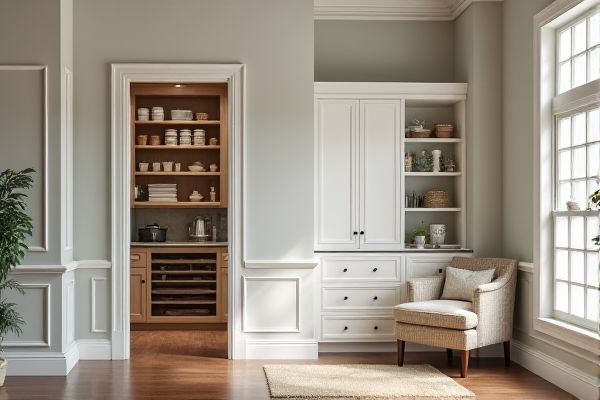
Freestanding pantries offer flexibility and easy relocation, while built-in pantries maximize kitchen space with a seamless, custom design tailored to your home's layout. Discover which pantry style best suits your storage needs and kitchen aesthetics by reading the rest of this article.
Table of Comparison
| Feature | Freestanding Pantry | Built-in Pantry |
|---|---|---|
| Installation | No installation required; movable | Permanent; requires professional installation |
| Space Utilization | Flexible placement but may take more floor space | Maximizes vertical and wall space efficiently |
| Customization | Limited customization; standard sizes | Highly customizable to fit exact kitchen layout |
| Cost | Generally lower initial cost | Higher cost due to materials and labor |
| Durability | Portable but less sturdy | Built to last with robust materials |
| Resale Value | Minimal impact on home resale value | Increases home resale value significantly |
| Design Integration | May not blend seamlessly with kitchen decor | Designed to match kitchen cabinetry and style |
Introduction to Freestanding vs Built-In Pantries
Freestanding pantries offer flexibility in placement and can be moved or replaced easily, making them ideal for renters or those who want adjustable storage solutions. Built-in pantries maximize kitchen space with customized shelving and a seamless look, enhancing home value and providing permanent organization. Choosing between the two depends on kitchen layout, budget, and long-term usage preferences.
Space Requirements and Kitchen Layout
Freestanding pantries offer flexibility for small kitchens, requiring minimal space and allowing easy relocation or adjustment. Built-in pantries maximize kitchen layout efficiency by utilizing wall recesses or unused corners, saving floor space and providing a streamlined, integrated appearance. Homeowners with larger kitchens benefit from built-in designs that enhance storage capacity without disrupting flow, while freestanding units suit compact areas with adaptable space needs.
Design Aesthetics and Customization
Freestanding pantries offer versatile design aesthetics with a variety of styles, finishes, and sizes that can be easily moved or replaced, catering to changing kitchen layouts. Built-in pantries provide seamless integration with cabinetry and walls, delivering a streamlined, custom look that maximizes space efficiency and enhances overall kitchen design. Customization of built-in pantries allows for tailored shelving, lighting, and door styles, creating a cohesive and personalized storage solution.
Storage Capacity and Organization
Freestanding pantries offer flexible storage solutions with adjustable shelves and easy rearrangement, ideal for accommodating various kitchen items and bulk goods. Built-in pantries maximize storage capacity by utilizing vertical space efficiently, providing custom organization options such as pull-out drawers, spice racks, and specialized compartments. Both designs enhance accessibility, but built-in units often provide a more streamlined, integrated storage experience tailored to specific kitchen layouts.
Installation Process and Flexibility
Freestanding pantries offer effortless installation, requiring no structural modifications, making them ideal for renters or those seeking temporary storage solutions. Built-in pantries demand professional installation, involving wall framing and custom cabinetry that integrates seamlessly into existing spaces. The flexibility of freestanding units allows for easy relocation or reconfiguration, whereas built-in pantries provide a permanent, tailored storage solution that maximizes space efficiency.
Cost Comparison: Upfront and Long-Term
Freestanding pantries typically have lower upfront costs, ranging from $100 to $1,000 depending on size and material, making them a budget-friendly option for immediate storage needs. Built-in pantries involve higher initial expenses, often between $2,000 and $10,000, due to customized design, installation, and potential remodeling costs, but they can increase home value and provide long-term durability. Over time, built-in units tend to offer better return on investment and enhanced storage efficiency, whereas freestanding pantries may require replacement or upgrades sooner, impacting long-term cost effectiveness.
Maintenance and Durability
Freestanding pantries offer easy maintenance due to their mobility, allowing for thorough cleaning underneath and behind the unit, but may be less durable as they are more susceptible to wear and tear or damage during relocation. Built-in pantries, constructed directly into the wall, provide superior durability with solid construction materials and seamless integration, reducing the risk of damage from movement while requiring occasional touch-ups to maintain cabinetry finishes. Proper care of hinges, shelves, and surface coatings is essential for both pantry types to ensure longevity and optimal functionality.
Resale Value and Home Appeal
A built-in pantry typically enhances home appeal and resale value by providing a seamless, custom look that maximizes kitchen space and storage efficiency. Freestanding pantries offer flexibility and portability but may be seen as less permanent or luxurious, potentially impacting buyer perception and resale price. Your choice can influence potential buyers, with built-in options often favored in real estate markets for their integrated design and added functionality.
Popular Brands and Models
Popular freestanding pantry brands include IKEA's BROR series and Sauder's HomePlus, offering versatile storage options with adjustable shelves and sleek designs ideal for varied kitchen sizes. Built-in pantries often feature models from California Closets and The Container Store's Elfa system, known for customizable features tailored to fit specific wall dimensions and optimize space efficiency. You can select a freestanding pantry for portability or a built-in pantry for a seamless, integrated kitchen look, depending on your storage needs and design preferences.
Making the Right Choice for Your Kitchen
Choosing between a freestanding pantry and a built-in pantry depends on your kitchen layout, storage needs, and budget. Freestanding pantries offer flexibility and easy relocation, ideal for renters or those needing extra storage without permanent modifications. Built-in pantries maximize space efficiency and add value by seamlessly integrating with cabinetry, providing a customized, durable solution for long-term use.
 homyna.com
homyna.com